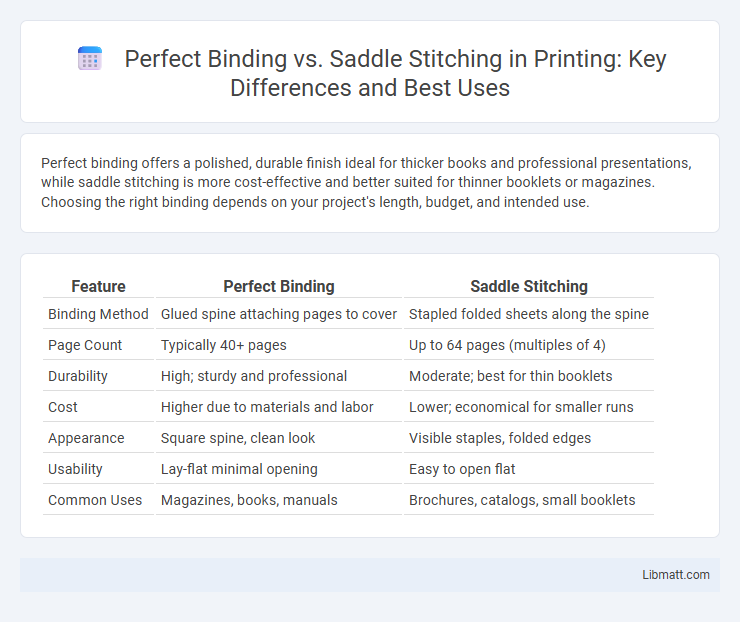Perfect binding offers a polished, durable finish ideal for thicker books and professional presentations, while saddle stitching is more cost-effective and better suited for thinner booklets or magazines. Choosing the right binding depends on your project's length, budget, and intended use.
Table of Comparison
| Feature | Perfect Binding | Saddle Stitching |
|---|---|---|
| Binding Method | Glued spine attaching pages to cover | Stapled folded sheets along the spine |
| Page Count | Typically 40+ pages | Up to 64 pages (multiples of 4) |
| Durability | High; sturdy and professional | Moderate; best for thin booklets |
| Cost | Higher due to materials and labor | Lower; economical for smaller runs |
| Appearance | Square spine, clean look | Visible staples, folded edges |
| Usability | Lay-flat minimal opening | Easy to open flat |
| Common Uses | Magazines, books, manuals | Brochures, catalogs, small booklets |
Introduction to Perfect Binding and Saddle Stitching
Perfect binding uses a strong adhesive to secure pages along the spine, creating a flat, professional-looking book ideal for thicker publications like magazines and catalogs. Saddle stitching involves folding sheets and stapling them through the fold, making it a cost-effective method best suited for smaller booklets, brochures, or pamphlets. Understanding these binding types helps you choose the right finish for your print project based on durability, thickness, and aesthetic needs.
What Is Perfect Binding?
Perfect binding is a popular bookbinding method in which the pages and cover are glued together at the spine with a strong, flexible adhesive, creating a flat, square edge. This technique is ideal for thicker publications such as magazines, catalogs, and paperback books, offering a professional and durable finish. Your choice of perfect binding ensures a polished appearance and long-lasting durability compared to saddle stitching, which uses folded sheets stapled through the center.
What Is Saddle Stitching?
Saddle stitching is a binding method where folded sheets are nested inside each other and stapled through the fold line with two or more metal staples, creating a secure and cost-effective booklet. This technique works best for booklets, catalogs, and magazines with a smaller page count, typically up to 64 pages. Compared to perfect binding, saddle stitching offers a flatter spine but is less durable and not suitable for thicker documents.
Key Differences Between Perfect Binding and Saddle Stitching
Perfect binding uses adhesive to secure pages within a squared spine, allowing for thicker booklets and a professional, book-like appearance. Saddle stitching involves folding sheets and stapling along the spine, ideal for thinner publications such as magazines and brochures. Key differences include durability, cost-effectiveness, and the total page count each method can accommodate.
Advantages of Perfect Binding
Perfect binding offers a polished, professional appearance with a sturdy spine that allows for easy flat-laying of books and magazines, enhancing readability. Its durability supports higher page counts compared to saddle stitching, making it ideal for thicker publications like catalogs, manuals, and novels. You benefit from the ability to print full-color spines with customizable designs, increasing branding opportunities and shelf appeal.
Advantages of Saddle Stitching
Saddle stitching offers cost-effective production with quicker turnaround times, making it ideal for smaller booklets and brochures. This binding method allows for a flatter spine, enabling your publication to lay open easily for better readability. Its minimal material usage contributes to sustainability, reducing overall waste compared to perfect binding.
Cost Comparison: Perfect Binding vs Saddle Stitching
Perfect binding generally incurs higher costs due to its complex adhesive process and durable spine, making it suitable for thicker booklets or magazines. Saddle stitching is more affordable and efficient for shorter publications or brochures with fewer pages since it uses staples along the fold. Your choice depends on budget constraints and the intended volume and longevity of the printed material.
Best Applications for Each Binding Method
Perfect binding is ideal for thick magazines, catalogs, and paperback books that require a professional, durable finish capable of withstanding frequent handling. Saddle stitching works best for thinner materials such as booklets, brochures, and small catalogs, providing a cost-effective and quick binding method suitable for up to 64 pages. Both binding methods optimize presentation and durability depending on publication length and intended use.
Durability and Aesthetic Considerations
Perfect binding offers superior durability due to its strong adhesive spine that securely holds together thicker booklets or magazines, making it ideal for long-lasting documents. Saddle stitching, using staples through the folded spine, provides a sleek, minimalist aesthetic but is best suited for thinner publications as it lacks the structural support of perfect binding. The choice between these methods hinges on balancing the desired longevity with the cleaner, cost-effective appearance of saddle-stitched materials.
How to Choose the Right Binding for Your Project
Choosing the right binding for your project depends on factors like page count, durability, and presentation style. Perfect binding works best for thicker documents, such as magazines or catalogs, providing a polished, professional appearance with a flat spine. Saddle stitching suits thinner booklets or brochures, offering cost-effective, fast production with a clean, foldable finish ideal for smaller page spreads.
perfect binding vs saddle stitching Infographic

 libmatt.com
libmatt.com